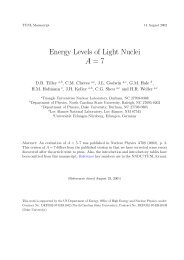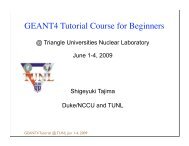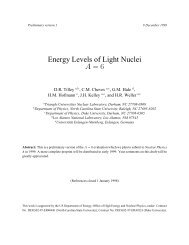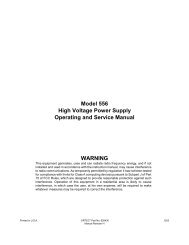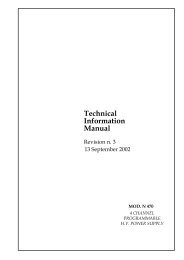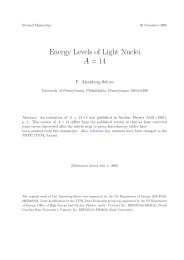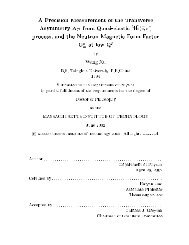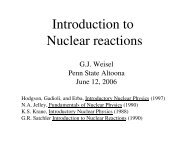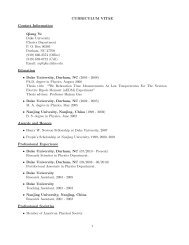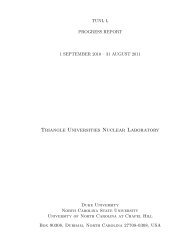Rf guns: bright injectors for FEL - Triangle Universities Nuclear ...
Rf guns: bright injectors for FEL - Triangle Universities Nuclear ...
Rf guns: bright injectors for FEL - Triangle Universities Nuclear ...
Create successful ePaper yourself
Turn your PDF publications into a flip-book with our unique Google optimized e-Paper software.
292<br />
C Travier / <strong>Rf</strong> <strong>guns</strong>: <strong>bright</strong> <strong>injectors</strong> <strong>for</strong> <strong>FEL</strong><br />
introduces mixing between longitudinal and transverse<br />
phase-space planes . A<strong>FEL</strong> design is based on this theory<br />
.<br />
3 3. CEA Bruyères-le-Châtel<br />
The Commissariat à l'Energie Atomique (CEA) in<br />
Bruy6res-le-Châtel (France) has built a laser-driven rf<br />
gun as an injector <strong>for</strong> a high-power infrared <strong>FEL</strong> [17] .<br />
In order to improve the beam characteristics, a frequency<br />
of 433 MHz was chosen <strong>for</strong> the linac and a subharmonic<br />
frequency of 144 MHz <strong>for</strong> the gun . At first,<br />
one cavity is used providing a 1 MeV beam (fig . 5) .<br />
Later, a second cavity will be added . Cs 3Sb and CsK,Sb<br />
photocathodes are used . Other types are also tested . The<br />
goal is to produce a 50-100 ps, 10-20 nC beam pulse .<br />
Design parameters [18] are summarized in table 2 . This<br />
gun is now under testing . An accelerating field of 25<br />
MV/m on the cathode has been obtained . 20 nC, 100<br />
ps pulses have been accelerated to 1 MeV . An emittance<br />
of 901T mmmrad was measured <strong>for</strong> a 10 nC pulse [191 .<br />
3 .4 . Brookhaven National Laboratory<br />
.<br />
In order to study several ideas related to future<br />
particle acceleration methods, Brookhaven National<br />
Laboratory (BNL) is building an accelerator test facility<br />
(ATF) [20] which will also be used <strong>for</strong> <strong>FEL</strong> physics . The<br />
injector <strong>for</strong> the accelerator is a laser-driven rf gun<br />
operating at 2856 MHz. It consists of a one and a half<br />
cell cavity incorporating a photocathode in the end wall<br />
of the first cell . The cavity shape was designed so that rf<br />
fields cause minimal nonlinear distortion of the phase<br />
spaces (fig . 6) . This was obtained by using a Fourier<br />
decomposition of the rf fields and by setting the radial<br />
field to be linear [21] .<br />
The gun is designed to operate with a 100 MV/m<br />
electric field at cathode. The laser will provide a 4 to 6<br />
ps pulse . 1 nC is expected from the yttrium photocathode<br />
The main design parameters are shown in table<br />
2 . The gun has already been tested with a 20 ns pulse<br />
from an excimer laser . A 90 MV/m accelerating field<br />
was obtained at the cathode . A peak current of 0.6 A<br />
was accelerated to 3.6 MeV [20] . The picosecond<br />
Nd : YAG laser is now available and experiments will<br />
proceed soon .<br />
Meanwhile, extensive studies of metallic photocathodes<br />
are done [22] .<br />
10 4 "<br />
~ M LASER-DRIVEN GUNS EXPERIMEN-AL RESU_TS<br />
-ASER-DRIVEN GUNS DESIGN<br />
PARAhETEPS<br />
HERMIONIC GJNS EX~EPir'ENTAL PARAMEIERS<br />
the <strong>bright</strong>ness as a function of the peak current and the<br />
bunch length respectively, <strong>for</strong> the different rf gun projects.<br />
These figures are only indicative and should be considered<br />
with some care . Fig . 7 also shows the <strong>bright</strong>ness<br />
corresponding to different wavelength <strong>FEL</strong> . From these<br />
figures a few general comments can be made. Both<br />
thermionic and laser driven rf <strong>guns</strong> have demonstrated<br />
their capability to produce very <strong>bright</strong> beams (roughly<br />
one order of magnitude higher than conventional <strong>injectors</strong>)<br />
. Thermionic rf <strong>guns</strong> provide smaller peak currents<br />
than photoinlectors . The best laser-driven rf gun should<br />
be sufficient to reach wavelengths m the XUV domain<br />
provided that suitable wigglers can be built <strong>for</strong> such<br />
short wavelengths . X-ray domain is out of reach <strong>for</strong> the<br />
current state of the art .<br />
E<br />
Q<br />
cn<br />
cn<br />
w<br />
z<br />
10' 4<br />
10 12<br />
10 100 1000 10000<br />
CURRENT (A)<br />
Fig. 7 <strong>Rf</strong> gun <strong>bright</strong>ness vs peak current .<br />
LASER-DRIVEN GUNS EXPERIMENTAL RESU-IS<br />
O LASER-D-2IVEN GUNS DESIGN PARAMETERS<br />
'HER - 1ONIC GUNS EXPERIMENTAL PARA - E - ERS<br />
4 . State of the art<br />
A figure of merit of the beam quality can be the<br />
peak <strong>bright</strong>ness defined here as two times the peak<br />
current divided by the square of the normalized emittance<br />
. It is expressed in A/(m 2 rad2 ) . Figs . 7 and 8 show<br />
ro<br />
10<br />
1 10 100 1000<br />
BUNCH LENGTH (PS)<br />
Fig . 8 . <strong>Rf</strong> gun <strong>bright</strong>ness vs bunch length


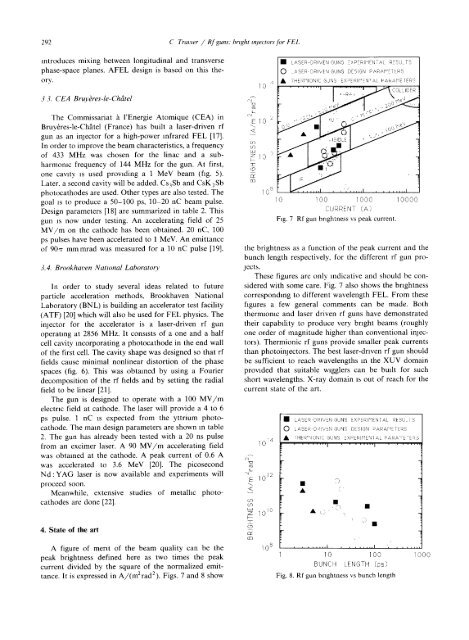
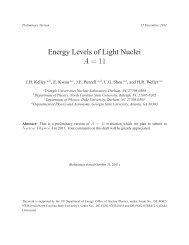
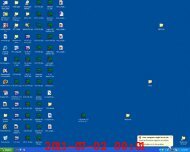
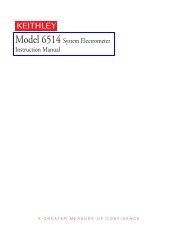
![TUNLXXXIV.tex typeset [1] - Triangle Universities Nuclear Laboratory](https://img.yumpu.com/47618358/1/190x245/tunlxxxivtex-typeset-1-triangle-universities-nuclear-laboratory.jpg?quality=85)
